THE burly British film crew gazes in wonder at
the image of the stunning young Indian woman on the playback monitor.
As her jeweled sari radiates ruby and amber across their faces,
the woman smiles out at her audience, stifles a giggle and draws
butterfly-wing lashes down over olive-green eyes. A pause, she
looks up, throws her head back and laughs, then withdraws into
another coy smile. The shot, five bewitching seconds that may
not even make the final edit of Bride and Prejudice, ends. The
crew doesn't move. Without a word, the tape is rewound and another
viewing begins. It is perhaps the seventh or eighth in a row.
"Marvelous," sighs an assistant director. His fellow
crew members nod in vigorous agreement. Behind them producer Deepak
Nayar beams at director Gurinder Chadha. "After this,"
chuckles Chadha, "she'll be able to do anything she wants."
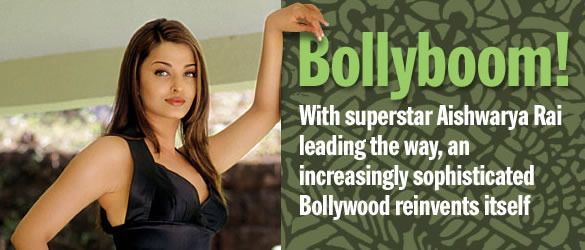
Aishwarya ("Ash") Rai has been a superstar in India
since she was crowned Miss World in 1994, so seducing a film crew,
even her first British one, doesn't faze her. "It's not just
about how I look," she says in the elegantly articulated
English of the Indian élite. Indeed, after a handful of
forgettable movies in the 1990s, Rai earned gushing reviews for
her performances in last year's Devdas, for which she won seven
Indian critic awards, and this fall's Chokher Bali. In Devdas
in particular, critics swooned over her transformation from innocent
lover to jilted avenger and agreed that she more than held her
own against Bollywood's biggest male star, Shahrukh Khan, and
Bombay's other queen, Madhuri Dixit. But Rai's looks—"the
most beautiful woman in the world," according to Julia Roberts—haven't
hurt her, either.
Rai turned Western heads this spring as a Cannes festival jury
member and the new face of cosmetics house L'Oreal. The attention
led to her invitation to the airy hills north of London, where
she is now playing the lead in Bride and Prejudice, Chadha's hotly
anticipated follow-up to her hit movie Bend it Like Beckham. Bride
is a modern, Bollywood version of Jane Austen's classic, in which
the Bennetts of Pemberley become the all-singing, all-dancing
Bakshis of Amritsar. But Rai's soaring star doesn't rely on one
film alone. Scarcely does she wrap Bride before rehearsals start
for The Rising, an epic based on the failed 1857 Indian rebellion
against British rule. Then, in March 2004, her agents confide
with considerable glee, the 29-year-old ex-model is slated to
start shooting opposite Meryl Streep in Chaos, French director
Coline Serreau's remake of her acclaimed drama about a housewife
who adopts a battered prostitute, a role that will mark a daring
departure for Rai. If that weren't enough to guarantee her arrival,
Rai is also talking to director Mira Nair (Mississippi Masala,
Monsoon Wedding) about a part in Homebody/Kabul, based on Tony
Kushner's play about the Taliban. And she's signed up to star
in India's first IMAX production, Taj Mahal. All five movies should
release worldwide over the next 18 months, by which time, Nair
predicts, Rai "will be the next Penelope Cruz."
But Cruz never brought along an entourage like
this. For although 2004 may be Rai's year, it is shaping up as
Bollywood's breakthrough, too. Following Rai westward will be
India's brightest male star, Aamir Khan, whose Lagaan (Land Tax)
was nominated for an Oscar in 2001 and who returns opposite Rai
in The Rising. Western audiences will also be introduced to Indian
art-house icon Rahul Bose, who will appear with Glenn Close in
Merchant Ivory's Heights, a contemporary tale of five affluent
New Yorkers. And behind the camera this trickle of A-list Indian
talent becomes a monsoon flood. In addition to its British-Indian
director, Bride and Prejudice combines the skills of legendary
Bollywood choreographer Saroj Khan and sought-after Bombay cinematographer
Santosh Sivan.
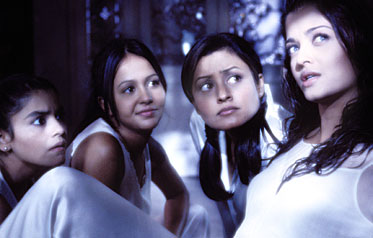 Meanwhile, director Shekhar Kapur (Elizabeth, Bandit Queen) has
announced a return to India with a $25 million production called
Paani (Water), set in 2060 Bombay but slated for a worldwide release.
Fellow auteur Vidhu Vinod Chopra is currently casting the thriller
Move 5 in Los Angeles. And Ugandan-Indian Nair will be unmissable
in 2004. She releases Vanity Fair, starring Reese Witherspoon;
takes Monsoon Wedding to Broadway; starts work with Rai on Homebody/Kabul;
directs a star-studded adaptation of British writer Hari Kunzru's
The Impressionist, and executive produces three Indian films under
a deal with Universal Studios worth up to $15 million. (Caption:
Ash in Bride and Prejudice, a take on Jane Austen's Pride and
Prejudice.)
Meanwhile, director Shekhar Kapur (Elizabeth, Bandit Queen) has
announced a return to India with a $25 million production called
Paani (Water), set in 2060 Bombay but slated for a worldwide release.
Fellow auteur Vidhu Vinod Chopra is currently casting the thriller
Move 5 in Los Angeles. And Ugandan-Indian Nair will be unmissable
in 2004. She releases Vanity Fair, starring Reese Witherspoon;
takes Monsoon Wedding to Broadway; starts work with Rai on Homebody/Kabul;
directs a star-studded adaptation of British writer Hari Kunzru's
The Impressionist, and executive produces three Indian films under
a deal with Universal Studios worth up to $15 million. (Caption:
Ash in Bride and Prejudice, a take on Jane Austen's Pride and
Prejudice.)
Nor is the traffic one way. Following 20th Century Fox's decision
to pick up The Rising, the first Indian-made movie that a Hollywood
studio will release worldwide, Warner Bros. and Columbia TriStar
Films are both planning to distribute Bollywood films abroad.
Going a step further, a handful of Western independents are inaugurating
a rash of East-West coproductions using Bombay's cheap, skilled
workforce. Shooting recently started on The King of Bollywood,
with British supermodel Sophie Dahl; and winter should see production
begin on Marigold, a story of an American B-movie actress stranded
in India.
It will all give a distinctly Indian flavor
to some of next year's biggest movies. And to their makers, stirring
in a little spice makes perfect sense. Chadha says her theft of
Austen will work because Bollywood shares themes with Western
art of a more innocent age. "When you see how perfectly the
plot of Pride and Prejudice fits Bollywood, you see how Austen
and Bollywood use the same language of joy, love, family and sadness
that's so uplifting and involving, and so rare and different from
Hollywood today," she says. "I think the audience will
eat it up." For Nair, the explanation is even simpler. "The
West is suddenly waking up, noticing what the rest of the world
has been watching all these years and working out where it came
from." She predicts more international exposure for Bollywood
as Hollywood realizes the commercial sense of combining the world's
two biggest film audiences.
Already, on the set of Vanity Fair, Bollywood's leap onto the
global stage has afforded her some deliciously surreal moments:
playing up Calcutta-born William Thackeray's Eastern influences
with a dance sequence, she says, "I had all these white folks,
these big stars, lined up, doing my thing, dancing to my Indian
tunes." Nair guffaws: "It was wonderful!"
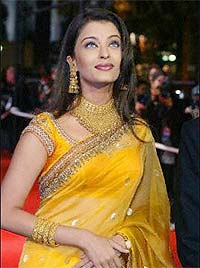 The
film world has heard rumors of an Indian invasion for years. In
London in particular, the success of cross-cultural writers like
Vikram Seth, Hari Kunzru and Monica Ali, Andrew Lloyd Webber's
Bombay Dreams, department store Selfridges' decision to adopt
a Bollywood theme, and a host of wildly successful Indian TV comedies
has long convinced the British public that it was set for a Bollywood
bonanza. Often, the sheer size of the Indian film industry—releasing
an average 1,000 films a year, compared with Hollywood's 740;
and attracting an annual world audience, from Kuala Lumpur to
Cape Town, of 3.6 billion, compared with Hollywood's 2.6 billion—made
it seem as though the West was the last to catch on. But even
though Chinese film boomed with Crouching Tiger, Hidden Dragon,
somehow the Indian wave never broke. And although Indian films
showed in theaters from Singapore to San Francisco, the truth
was that few Asians, Europeans or Americans outside the vast South
Asian immigrant community actually saw them.
The
film world has heard rumors of an Indian invasion for years. In
London in particular, the success of cross-cultural writers like
Vikram Seth, Hari Kunzru and Monica Ali, Andrew Lloyd Webber's
Bombay Dreams, department store Selfridges' decision to adopt
a Bollywood theme, and a host of wildly successful Indian TV comedies
has long convinced the British public that it was set for a Bollywood
bonanza. Often, the sheer size of the Indian film industry—releasing
an average 1,000 films a year, compared with Hollywood's 740;
and attracting an annual world audience, from Kuala Lumpur to
Cape Town, of 3.6 billion, compared with Hollywood's 2.6 billion—made
it seem as though the West was the last to catch on. But even
though Chinese film boomed with Crouching Tiger, Hidden Dragon,
somehow the Indian wave never broke. And although Indian films
showed in theaters from Singapore to San Francisco, the truth
was that few Asians, Europeans or Americans outside the vast South
Asian immigrant community actually saw them.
Ash arrives as
jury member at the 2003
Cannes Film Festival, France.
The reason was not hard to fathom. However deep the artistic void
that gave the world Death Wish V or Police Academy 7, Bollywood
has long outdone Hollywood for formula and cliché. After
a two-decade-long golden age that produced films such as Mother
India (1957) and Sholay (1975), the industry slipped into a succession
of hackneyed action flicks and copycat song-and-dance romances
made under a factory ethic in which actors worked on five, 10,
even 15 films at a time. Remakes and plagiaries of Hollywood were
routine, scripts were almost unheard of, and cast and crew often
took the same characters, shots and dance steps from one production
to another. The love stories were particularly indistinct: thousands
of boys met thousands of girls (songs of joy!), broke up (songs
of sorrow!), reunited (joy!) and led a cast of hundreds to a meadow
outside Zurich for a leaping, ululating and face-achingly joyous
finale. Actors sleepwalked through careers. "You can't imagine
what it was like," says Anupam Kher, star of 290 films in
18 years, who reprises his role as the father from Bend it Like
Beckham in Bride and Prejudice. "After the whole fame thing
wears off, you begin to wonder, 'Really, what the hell am I doing?'"
Even domestic audiences complained, including India's leader.
"Why do our films stick to stereotype?" lamented Prime
Minister Atal Bihari Vajpayee after seeing Devdas, which for all
its well-deserved critical praise, was still the 12th version
of the same love story since the original 1928 silent movie. By
mid-2002, Bollywood was largely a commercial concern—to
this day, critics rate films and actors almost entirely by box-office
pull—of little interest to anyone outside South Asia, except
homesick migrants and the odd film buff.
So what's changed? Everything. Rai's unchallenged position in
the industry is partly due to her determined pursuit of "different,
against the grain" roles, such as her 1997 part in Tamil
director Mani Rathnam's little-seen but acclaimed art-house movie
Iruvar. But Rai is not some solitary crusader, rather the most
successful disciple of a new mantra of innovation that has swept
Indian film in the past year. Because in 2002 Bollywood truly
bombed. All but 12 of the year's 132 mainstream Hindi releases
flopped, and the $1.3 billion-a-year industry, used to comfortable
annual growth of 15%, groaned under unaccustomed losses of some
$60 million. The formulas suddenly weren't commercial anymore.
And although some moviemakers groped around for new blueprints—horror,
skin flicks, anything—a band of urban and Westernized writers,
directors, producers and actors, loosely grouped under the banner
"New Bollywood," overran the industry. "Overnight,
those of us who didn't think the audience was dumb and who were
sick of movies being talked about as 'products' were in charge,"
says producer-of-the-moment Pritish Nandy. "The old generation
lost control, and the new generation just walked in."
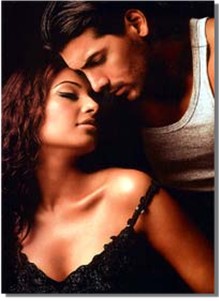 (Left,
Bipasha Basu and John Abraham in Jism.)
(Left,
Bipasha Basu and John Abraham in Jism.)
Today, fresh ground is broken with every release. Out are fluffy
romances. In are films such as Jism (Body) [ Note, Mumbai Matinee
and Khwahish (Desire) that have shattered Bollywood's tradition
of prudish sex scenes, by making previously taboo kisses routine
and by finally ditching the rustling bushes that used to denote
what came next. Out are badly dubbed punchups and in are dark
stories like the true tale of Bombay's rival crime lords (Company)
or India's Hindu-Muslim divide (Mr. and Mrs. Iyer), weird stories
like that of a hairdresser who reads minds (Everybody Says I'm
Fine) or a retired judge who literally runs off with a young model
(Jogger's Park) or dark and weird tales like the one of a failed
rock singer who leads his bandmates to murder (Paanch). Urban,
middle-class films like Dil Chahta Hai (Do Your Thing) are proving
there is money in ignoring India's rural audiences, whose preferences
run to the spectacular, the musical and, invariably, the alpine.
Some films are even leaving out the songs. Director Ram Gopal
Varma dropped the music from both Company and his smash horror-thriller
Bhoot (Ghost). "It doesn't make sense to a Western audience,"
Varma explains over drinks at Bombay's Hyatt Hotel. "I live
in this country, and I've still not got used to it. And, frankly,
I couldn't give a f--- for the villages." (During the conversation,
Varma took a revealing call from a film distributor in Dubai.
He cheerfully informed the caller, "There is no music in
the film, only background music. You won't really hear it."
He then turned to a TIME reporter, grinning, with his hand over
his phone, and laughed, "'No songs! No songs!' He's having
a heart attack." After hanging up, he added: "I'm in
that position now, you know? 'F--- you! Take it or get out!'")
If music is used today, it's for a reason. Bride
and Prejudice choreographer Saroj Khan, 55, says that for 600
films she did nothing but "item numbers," dance sequences
inserted with little regard for narrative. "Now suddenly
I have a story to work with," she says. "You won't believe
me, but that's very different. And very nice." Concludes
Kaizad Gustad, director of Boom (about three supermodels who must
somehow find the money to pay for 30 Mob-owned diamonds they've
lost): "Suddenly, the newer and riskier the project, the
greater the chance of it getting made."
Propelled by this whirlwind of raw creativity, star after star
is breaking type and embracing new roles, recharging some long-languishing
talents. Like Rai, Bombay legend Amitabh Bachchan is trying something
different, raising eyebrows with his portrayal of the stylishly
amoral, Bo Derek-obsessed crime kingpin in Boom. "It's a
crazy film by a crazy guy," offers the 61-year-old with evident
delight while on the set of his new war movie Lakshya (Target).
And producer Nandy cheerfully expects a torrent of outrage upon
release of the gritty Chameli, as megastar Kareena Kapoor dumps
her customary chaste refinement to play the streetwalker of the
film's title opposite Rahul Bose's banker. The head of 20th Century
Fox's Indian arm, Aditya Shastri, describes the industry as suddenly,
and fundamentally, transformed. "It takes a very brave or
very foolish person to do a traditional song-and-dance movie today,"
he says. Bose, who as the star of Chameli, Mr. and Mrs. Iyer,
Mumbai Matinee and Everybody Says I'm Fine is the ubiquitous face
of New Bollywood, goes further: "Put us all together, and
you have a movement. Put us together with the audience, and you
have something sweeping the world."
On the set of Bride and Prejudice, Rai is already coping with
some of the pitfalls of the revolution. After every scene, she
quietly slips past the longing stares of 100 Indian extras and
retreats to her cordoned-off trailer. This past year she has already
endured her own "Bennifer" style press attention when
she split from fellow movie star Salman Khan only to link up with
the star of Company, Vivek Oberoi. The size of her celebrity is
measured by the 17,000 unofficial websites in her name and the
immediate overloading and crash of her own official site the moment
it was launched this spring. Ensconced in her trailer, she admits
to having "so little time to myself and for my sanity. Last
summer, I had meetings with Robert De Niro and Roland Joffé
and Mike Leigh," she says. "They'd say, 'When are you
available?' And I'm like, 'Maybe at the end of next year.' And
they're like, 'Wow, you can't be serious.' But that's my life
right now."
Indeed, Rai seems to have little time even to sleep: she scheduled
both her photo shoots with TIME for the middle of the night, saying
it was her only free time, before crying off exhausted on the
second shoot and finding a spare two hours the following day.
But you won't hear Rai complain. "I can always choose to
do something else," she shrugs. And she seems to accept that
as a model turned actress with no training, she's on a steep,
and tiring, learning curve. "I'm a student," she says,
hands folded neatly in front of her. "I want to do better,
and I want directors who can find the actress in me and be my
teachers." But like many of Bombay's bigger stars, one of
her first lessons was to turn herself into something of a recluse,
never discussing her private life and rarely being photographed
in public. "I like my work, and I'm true to it; and apart
from that, I'm just being," she says.
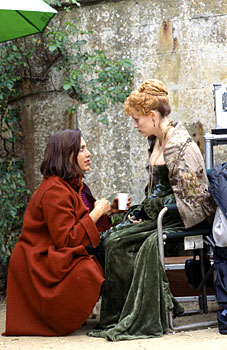

Mira
Nair (with Reese Witherspoon on the set of the upcoming Vanity
Fair) is everywhere in 2004: Along with Vanity Fair, Nair
is
working
on two star-studded literary adaptations and a Broadway production
of her hit Monsoon Wedding. Note poster at
right.
In between. In between, she's executive-producing on a three-picture
deal with Universal Studios worth $15 million.
Overwhelmed by the demands on their time or simply by their own
importance, lead actors in Bollywood would in the past jeopardize
entire productions by double-booking themselves, turning up hours
late on set (sometimes not appearing at all) or raising fees midway
through a shoot. But bigger names, such as Rai and Bose, are now
signing with Western talent agencies (both are with the gilt-edged
William Morris Agency) that ensure commitments are honored. Amitabh
Bachchan, who for years set a lonely example of professionalism
in Bollywood, couldn't be happier. "It's a joy to be working
like this," he says. "To end the disorganization that
has ruled for so long, it's an absolute delight."
It's all part of a newfound professionalism in Bollywood that
is evident both artistically and financially. On the set of Lakshya,
at Film City studios outside Bombay, this new regimen is in full
effect. Director Farhan Akhtar and producers UTV have fixed a
budget of $7 million (large by Bollywood standards), issued contracts
to crew and actors, insisted on a finished script, insured the
set and laid out a meticulously detailed schedule for months of
continuous shooting in Bombay and Ladakh. Such black-and-white
commitments may be rudimentary in the West but are almost unprecedented
in an industry in which a quiet word or a handshake have long
sealed deals and in which films were shot piecemeal over a number
of years.
Likewise, the financing of Bollywood movies has become far less
murky. In the 1990s, a series of scandals broke about the links
between Bombay's movie world and the underworld. Producers were
the target of repeated police investigations into how deeply Mob
money had penetrated the movies, and top actors who were called
to testify often sensationally refused. Indeed, just last month,
Devdas producer Bharat ("King of Bollywood") Shah was
sentenced to a year in jail (but released due to time served)
for concealing the underworld's involvement in his 2000 movie
Chori Chori, Chupke Chupke (On the Quiet, Hush Hush). In the past,
such attachment to Mob money and the conditions that came with
it—flying stars to Dubai, Pakistan or South Africa to indulge
gangsters' egos—proved a major deterrent to Western investors.
But today, even Bombay's police admit the connection with the
underworld is weakening—a transformation that began in October
2000, when India's bureaucrats finally lifted outdated restrictions
on Bollywood's access to banks and private investors. As legitimate
funds poured in from respectable backers, so a new culture of
legal and transparent business practices swept the industry.
New Bollywood is not there yet. Director Nair estimates that it
will be "two or three years" before its movies attain
what she calls Western-style "craft and rigor," and
UTV's founder, Ronnie Screwvala, adds that it will take "three
to five years" before Western business practices become standard.
In the meantime, maybe the greatest danger of Bollywood's invasion
of the West is that the West might invade right back. Director
Varma's urbanized zeal for Hollywood—"anyone who doesn't
follow the West is gone"—carries with it the danger
that, in less-skilled hands, Indian film could become little more
than exotic imitation. Although he admits to enjoying how well
the world received Lagaan and although he welcomes New Bollywood's
energy, actor Aamir Khan warns that a wholesale rejection of song
and dance might kill the "color, fire and innocence"
that defines Indian cinema. "Of course, Bollywood can be
quite ghastly," he says. "But at its best, it's a wonderful
form. There's a level of passion and excitement and a heightening
of emotions which can be momentous. It'd be awful to lose it."
With Rai as India's standard bearer, there is
little immediate danger of that. She may position herself as New
Bollywood in terms of roles, but in person Rai embodies the Indian
middle-class—and very Old Bollywood—ideal: a modern
girl with traditional values. For someone emerging as a 21st century
film star, there are few people less likely to turn into a Western-style
sex kitten. Asked about her image as every Indian man's dream
girl, she replied: "I'm just being the girl I was brought
up to be." In fact, it is because Rai is such a paragon of
age-old, dutiful Indian femininity, says producer Nayar, that
she was so right for the headstrong but obedient Elizabeth Bennett
character, Lalita. "That's her appeal," says Bride and
Prejudice co-star Martin Henderson. "When Hollywood women
are so exposed—when you see ass cheeks hanging out on MTV,
for God's sake—there's something wonderful about a woman
who is sensible and refined, mysterious and sensual."
In an age of terror, perhaps it makes sense for audiences to yearn
for a more innocent time. Rai agrees that although New Bollywood
may represent a welcome reinvigoration of a tired industry, the
reason she is suddenly attracting a global audience is the same
reason that Bollywood has always drawn adulation from millions
of Indians. "It's the chance to be transported from the toil
and the worry," she says, "the chance to feel good about
life again." Whatever the innovations of the new Indian wave,
the true essence of Bollywood, she says, will always be "a
world of hope and color and positivity, the innocent, beautiful
fairy tale." So is this the beginning of a storybook adventure
for her and Indian cinema? Why not? As she says, "In Bollywood,
it's always a happy ending."
[Editor's Note: All credits to
TIME ASIA except title herein, the captions, the Rai photo at
Cannes, and the poster for Monsoon Wedding. The first photo as
been edited.]

 Meanwhile, director Shekhar Kapur (Elizabeth, Bandit Queen) has
announced a return to India with a $25 million production called
Paani (Water), set in 2060 Bombay but slated for a worldwide release.
Fellow auteur Vidhu Vinod Chopra is currently casting the thriller
Move 5 in Los Angeles. And Ugandan-Indian Nair will be unmissable
in 2004. She releases Vanity Fair, starring Reese Witherspoon;
takes Monsoon Wedding to Broadway; starts work with Rai on Homebody/Kabul;
directs a star-studded adaptation of British writer Hari Kunzru's
The Impressionist, and executive produces three Indian films under
a deal with Universal Studios worth up to $15 million. (Caption:
Ash in Bride and Prejudice, a take on Jane Austen's Pride and
Prejudice.)
Meanwhile, director Shekhar Kapur (Elizabeth, Bandit Queen) has
announced a return to India with a $25 million production called
Paani (Water), set in 2060 Bombay but slated for a worldwide release.
Fellow auteur Vidhu Vinod Chopra is currently casting the thriller
Move 5 in Los Angeles. And Ugandan-Indian Nair will be unmissable
in 2004. She releases Vanity Fair, starring Reese Witherspoon;
takes Monsoon Wedding to Broadway; starts work with Rai on Homebody/Kabul;
directs a star-studded adaptation of British writer Hari Kunzru's
The Impressionist, and executive produces three Indian films under
a deal with Universal Studios worth up to $15 million. (Caption:
Ash in Bride and Prejudice, a take on Jane Austen's Pride and
Prejudice.) The
film world has heard rumors of an Indian invasion for years. In
London in particular, the success of cross-cultural writers like
Vikram Seth, Hari Kunzru and Monica Ali, Andrew Lloyd Webber's
Bombay Dreams, department store Selfridges' decision to adopt
a Bollywood theme, and a host of wildly successful Indian TV comedies
has long convinced the British public that it was set for a Bollywood
bonanza. Often, the sheer size of the Indian film industry—releasing
an average 1,000 films a year, compared with Hollywood's 740;
and attracting an annual world audience, from Kuala Lumpur to
Cape Town, of 3.6 billion, compared with Hollywood's 2.6 billion—made
it seem as though the West was the last to catch on. But even
though Chinese film boomed with Crouching Tiger, Hidden Dragon,
somehow the Indian wave never broke. And although Indian films
showed in theaters from Singapore to San Francisco, the truth
was that few Asians, Europeans or Americans outside the vast South
Asian immigrant community actually saw them.
The
film world has heard rumors of an Indian invasion for years. In
London in particular, the success of cross-cultural writers like
Vikram Seth, Hari Kunzru and Monica Ali, Andrew Lloyd Webber's
Bombay Dreams, department store Selfridges' decision to adopt
a Bollywood theme, and a host of wildly successful Indian TV comedies
has long convinced the British public that it was set for a Bollywood
bonanza. Often, the sheer size of the Indian film industry—releasing
an average 1,000 films a year, compared with Hollywood's 740;
and attracting an annual world audience, from Kuala Lumpur to
Cape Town, of 3.6 billion, compared with Hollywood's 2.6 billion—made
it seem as though the West was the last to catch on. But even
though Chinese film boomed with Crouching Tiger, Hidden Dragon,
somehow the Indian wave never broke. And although Indian films
showed in theaters from Singapore to San Francisco, the truth
was that few Asians, Europeans or Americans outside the vast South
Asian immigrant community actually saw them.  (Left,
Bipasha Basu and John Abraham in Jism.)
(Left,
Bipasha Basu and John Abraham in Jism.)
